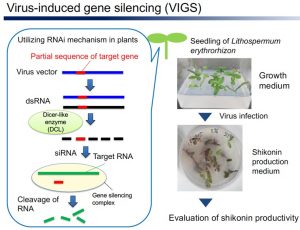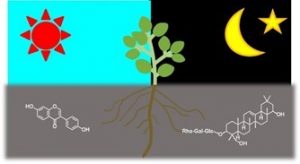2020 Activity Report for Mission 5-1: Harmonization of Human Health and the Environment
Updated: 2021/04/30
Research 1-1: Production of bioactive compounds from plant biomass
Principal Investigator (PI): Takashi Watanabe (RISH, Kyoto University)
Research collaborator(s): Hiroshi Nishimura, Ruibo Li, Chihiro Kimura, Yumi Okabe, Tatsuya Miyazaki (RISH, Kyoto University), Ryota Ouda (Graduate School of Medicine, Hokkaido University), Takashi Fujita (Institute for Frontier Life and Medical Sciences, Kyoto University), Osamu Matsuda, Eriko Ohgitani, (Graduate School of Medicine, Kyoto Prefectural University of Medicine)
We studied production of antiviral and antitumor compounds by microwave degradation of wood and sugarcane bagasse in collaboration with Institute for Frontier Life and Medical Sciences, Kyoto University and Kyoto Prefectural University of Medicine, aiming at establishment of safe and healthy living and biorefinery. In FY 2020, we found that chemical degradation of wood and sugarcane bagasse produced antiviral lignin by alteration of its chemical structure. We also found that microwave solvolysis of woody biomass produced antiviral lignin-carbohydrate complex (LCC) in which carbohydrate chains play a key role for the activity.
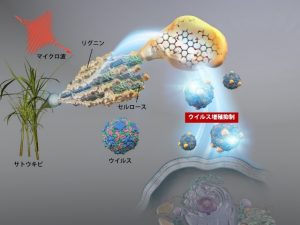
Antiviral activity of lignin fractions from sugarcane bagasse separated by microwave solvolysis against EMCV.
Publications, etc.
- Original article
Kimura, C., Li, R., Ouda,R., Nishimura, H., Fujita, T., Watanabe, T., Production of Antiviral Substance from Sugarcane Bagasse by Chemical Alteration of its Native Lignin Structure through Microwave Solvolysis, ChemSusChem, 13, 4519-4527 (2020). DOI:10.1002/cssc.202000490 - Press release
Production of antiviral compounds by chemical degradation of sugarcane bagasse -Contribution to the infection control and utilization of biomass, May 29, 2020 (Kyoto Univ.)
(Kyoto Univ.)https://www.kyoto-u.ac.jp/ja/research-news/2020-05-29-1 - News paper
Kagaku Kogyo Nippo, Jun 3, 2020; Nikkan Kogyo Shimbun, Jun 5, 2020; The Japan Agricultural News, Jun 25, 2020. - Presentation
Takashi Watanabe、Production of antiviral compounds from biomass, The 14th Special seminar of Forum for Sustainable Humanosphere, Sustainable Humanosphere Science for Post-Corona Era, Nov 7th, 2020, Uj, and 2 presentations at domestic academic meetings.
Research 1-2: Production mechanism of bioactive compounds and biotechnology
Principal Investigator (PI): Kazufumi Yazaki (RISH, Kyoto University)
Research collaborator(s): Akifumi Sugiyama (RISH, Kyoto University), Ryosuke Munakata (RISH, Kyoto University), Bunta Watanabe (ICR, Kyoto University), Kojiro Takanashi (Shinshu University), Nobuyuki Yoshikawa (Iwate University), Chikara Masuta (Hokkaido University), Hirobumi Yamamoto (Toyo University), Akimori Wada (Kobe Pharmaceutical University), Yumiko Yamano (Kobe Pharmaceutical University)
Many lipophilic plant secondary metabolites exhibit strong biological activities and some are prescribed in clinical fields, e.g., vincristine and paclitaxel serving as anti-cancer drugs, while a large portion of their biosynthesis and secretion mechanisms from the cells remain to be clarified. Shikonin, a lipophilic bioactive secondary metabolite of Lithospermum erythrorhizon provides a model system suitable for study production mechanism of high value plant metabolites. The entire biosynthetic pathway is, however, still under investigation. In this fiscal year, we clarified an important biosynthetic step using cell-free extract of this cell culture. In addition, we established a virus-induced gene silencing system by use of a domestic plant virus, apple latent spherical virus (ALSV). The scientific knowledge obtained from these studies will be helpful to understand the production mechanism of lipophilic bioactive metabolites in plants and be applied for the production of plant-derived valuable drugs, such as paclitaxel utilized for cancer treatments.
Publications, etc.
- Yamamoto, H., Tsukahara, M., Yamano, Y., Wada, A., Yazaki, K., Alcohol dehydrogenase activity converts 3″-hydroxygeranylhydroquinone to an aldehyde intermediate for shikonin and benzoquinone derivatives in Lithospermum erythrorhizon, Plant Cell Physiol., 61, 1798-1806 (2020).
- Izuishi, Y., Isaka, N., Li, H., Nakanishi, K., Kageyama, J., Ishikawa, K., Shimada, T., Masuta, C., Yoshikawa, N., Kusano, H., Yazaki, K., Apple latent spherical virus (ALSV)-induced gene silencing in a medicinal plant, Lithospermum erythrorhizon, Rep., 10, Article 13555 (2020).
- Tatsumi, K., Ichino, T., Onishi, N., Shimomura, K., Yazaki, K., Highly efficient method of Lithospermum erythrorhizon transformation using domestic Rhizobium rhizogenes strain A13, Plant Biotech., 37, 39-46 (2020).
- Oshikiri, H., Watanabe, B., Yamamoto, H., Yazaki, K., Takanashi, K., Two BAHD acyltransferases catalyze the last step in the shikonin/alkannin biosynthetic pathway, Plant Physiol., 184, 753-761 (2020).
Research 1-3: Establishment of unit reaction for biological production of antitumor lignans
Principal Investigator (PI): Toshiaki Umezawa (RISH, Kyoto University)
Research collaborator(s): Keisuke Kobayashi, Mitsuki Hirota, Masaomi Yamamura, Yuki Tobimatsu (RISH, Kyoto University)
Lignan is a class of phenylpropanoid dimers liked via C8-C8′ side chains of two phenylpropane units. Lignan has various biological activities. Among them, podophyllotoxin is an anti-tumor lignan and establishment of a stable biolotechnological production systems of the lignan is desired. In this study, we have attempted to clone cDNAs encoding enzymes involved in the antitumor lignan biosynthesis and to characterize the enzymes. In this school year, we successfully identified enzyme gene encoding pinoresinol/lariciresinol reductase (PLR), which catalyzes a reaction step upstream of lignan biosynthetic pathway, and 2-oxoglutarate-dependent dioxygenase (2ODD), which catalyzes cyclization reaction of yatein downstream of the pathway. Currently, we are characterizing PLR and 2ODD using each recombinant protein.
Publications
- Kobayashi K, Yamamura M, Kumatani M, Ono E, Shiraishi A, Satake H, Umezawa T, The 71th Annual Meeting of the Japan Wood Research Society, Tokyo (on-line), March 19-21, 2020 (Oral)
Research 1-5: Identification of transporters for bioactive compounds and their application for production
Principal Investigator (PI): Akifumi Sugiyama (RISH, Kyoto University)
Research collaborator(s): Shinjiro Ogita (Prefectural University of Hiroshima.), Nobukazu Shitan (Kobe Pharmaceutical University) 、Yuichi Aoki(Tohoku University)、Atsushi J. Nagano(Ryukoku University)
Although caffeine is known to be secreted during germination, no caffeine transporters have been identified in coffee plants. We aimed to identify and analyze the function of caffeine transporters. In addition, plant alkaloids, are important for human health, and sustainable production is required. This year we analyzed the transport of tomatine. We also analyzed diurnal transcriptome of soybean and identified several candidate transporter genes for isoflavone and soyasaponin transport.
Publication
- Matsuda, H., Nakayasu, M., Aoki, Y., Yamazaki, S., Nagano, A. J., Yazaki, K., Sugiyama A. (2020) Diurnal metabolic regulation of isoflavones and soyasaponins in soybean roots. Plant Direct 4, e00286.
Research 2: Biological effects of electromagnetic fields
Principal Investigators (PI): Junji Miyakoshi, Naoki Shinohara (RISH, Kyoto University)
An epigenetic test with 400 kHz exposure was conducted using human-derived skin cells to find out how electromagnetic fields used in wireless power transfer (WPT) systems affect living organisms.
There is growing international debate about the effects of exposure to electromagnetic waves on human health. We are conducting research on the effects of electromagnetic field exposure through experiments at the cellular and genetic levels. As the research theme in 2020, we searched for the effects of electromagnetic fields on epigenetics as a safety evaluation of living organisms by wireless power transmission systems in the living environment. Epigenetics is one of the effects of electromagnetic fields (including radiation) that causes gene expression control without DNA cleavage (no change in the base sequence). It is a mechanism that bridges genes and environmental factors, and it has been suggested that it may be involved in cancer and various diseases, and it has received a great deal of attention in recent years. Epigenetics indicators can be broadly divided into two types: DNA methylation and histone modification, and the structural changes in chromatin caused by these are investigated.
An epigenetic test with 400 kHz exposure was performed using human-derived skin cells (CCD32Sk). The 400kHz exposure (conditions: 160A / m, 1 hour) was performed. A DNA extraction kit was used for the analysis of DNA methylation (5-methylcytosine: 5-mc). A histone extraction kit was used for the analysis of histone modifications (acetylation, methylation). Significant differences were examined by statistical processing (Dunnett’s test) at n = 3. The results are shown in Figures 1 to 4.
We have conducted genetic toxicity tests, skin immunity tests, and epigenetics tests as evaluation indexes for electromagnetic field response in Mission research. A decreasing or an increasing trend was observed in some responses, but no statistical significance was observed. Therefore, it is considered that the influence of 400 kHz exposure on these cell responses is not or extremely low.
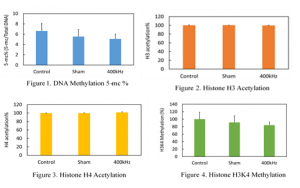
Figures 1 – 4. Epigenetic effects of electromagnetic fields on human-derived skin cells In the analysis of DNA methylation, histone modification as acetylation and methylation, although there is a decreasing tendency for DNA and histone modification methylation, the effect of 400kHz exposure on epigenetics will be not or very low.
Publications etc.
- J.Miyakoshi, H. Tonomura, S. Koyama, E. Narita, N. Shinohara, Effects of exposure to 5.8 GHz electromagnetic field on micronucleus formation, DNA strand breaks, and heat shock protein expressions in cells derived from Human eye. IEEE Xplore, Engineering in Medicine and Biology Society, 18(2): 257-260 (2019).
- Junji Miyakoshi, Cellular Effects of Radio Frequency, Millimeter, and Terahertz Waves; in “Biological and Medical Aspects of Electromagnetic Fields, Fourth Edition” (eds. Ben Greenebaum and Frank Barnes), The Handbook of Biological Effects of Electromagnetic Fields, CRC Press (Taylor & Francis Group) London, pp 69-88. (2019)
Research 3: Air quality issues in outdoor and indoor environments
Principal Investigator (PI): Kenshi Takahashi and Masanori Yabuki (RISH, Kyoto University)
Human activities increasingly influence the Earth’s climate and ecosystems. For instance, humans change the atmospheric aerosol loadings by emitting primary aerosol particles and a variety of trace gases that could be chemically transformed to give aerosol particles. Aerosol particles impact the Earth’s climate on a regional and global scale. Our study aims to develop in-situ and remote sensing techniques for observing trace gases and aerosol particles and their applications to outdoor and indoor measurements, which is closely linked to air quality issues in outdoor and indoor environments. In FY2020, we have performed continuous measurements of atmospheric pollutants in the central of Sakai-city, Osaka-Prefecture, that is one of the largest cities in Japan. The eye-safe mobile vehicle lidar was developed to achieve the continuous monitoring of atmospheric pollutants with high spatio-temporal resolutions in populated urban areas.
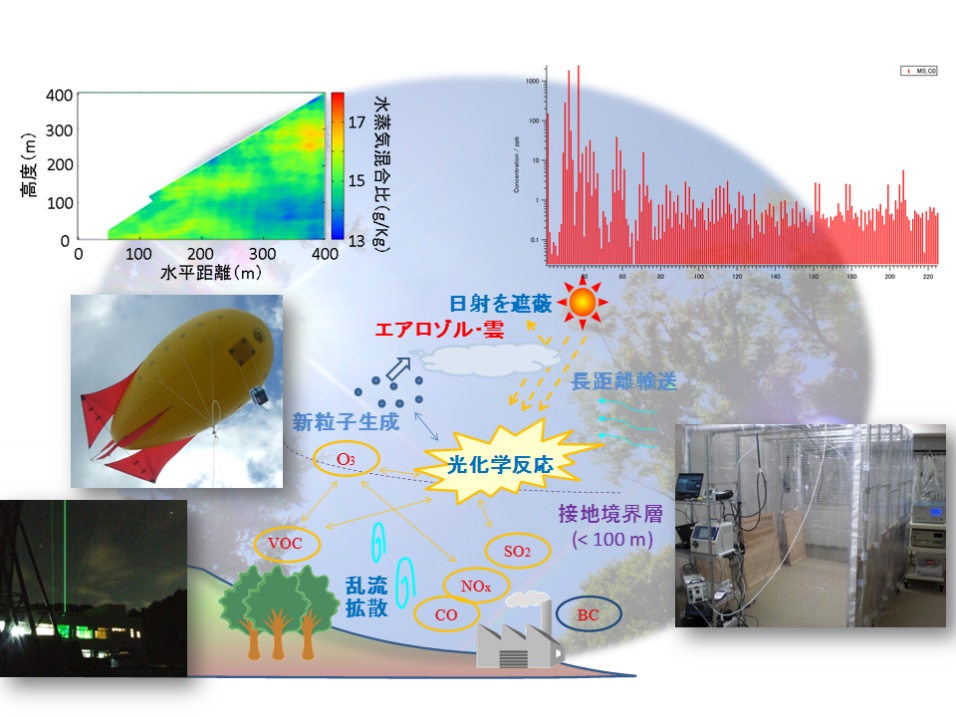 Development of new techniques for exploring spatio-temporal variations of atmospheric trace molecules and aerosol particles in outdoor and indoor environments.
Development of new techniques for exploring spatio-temporal variations of atmospheric trace molecules and aerosol particles in outdoor and indoor environments.
Publications
- Yabuki, M., K. Fujii, K. Miura, T. Mori, H. Hayami, H. Kuze, and Y. Saito, Aerosol spatial distributions over high-rise buildings observed by a mobile vehicle lidar for near-range detection, 38th Japanese Laser Sensing Syposium, Sep. 3-4, 2020.


